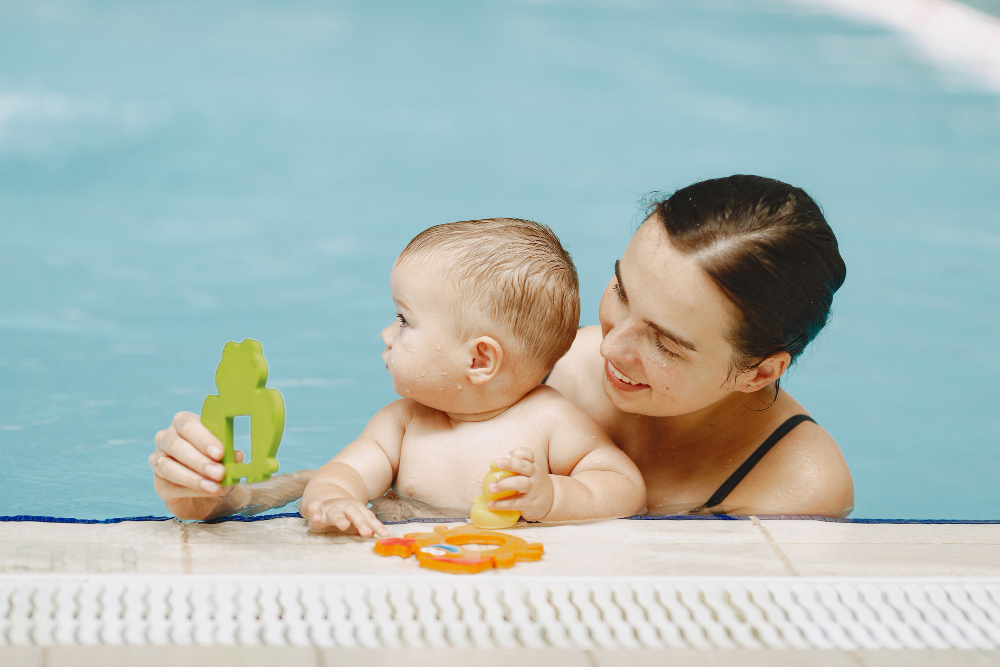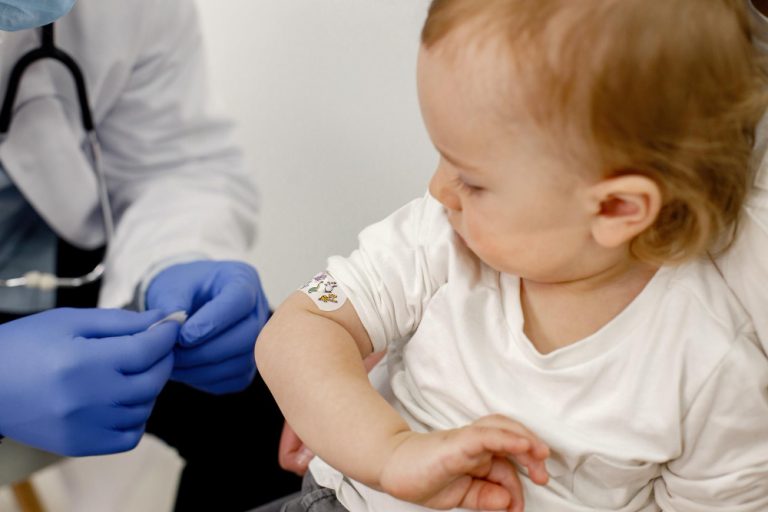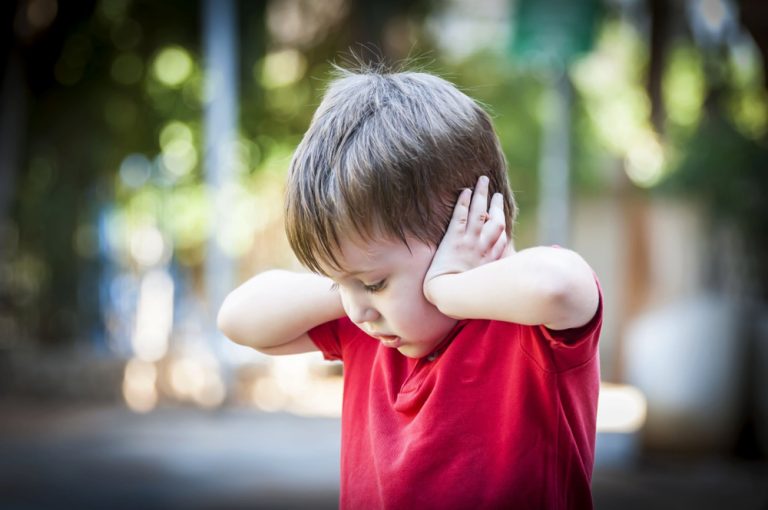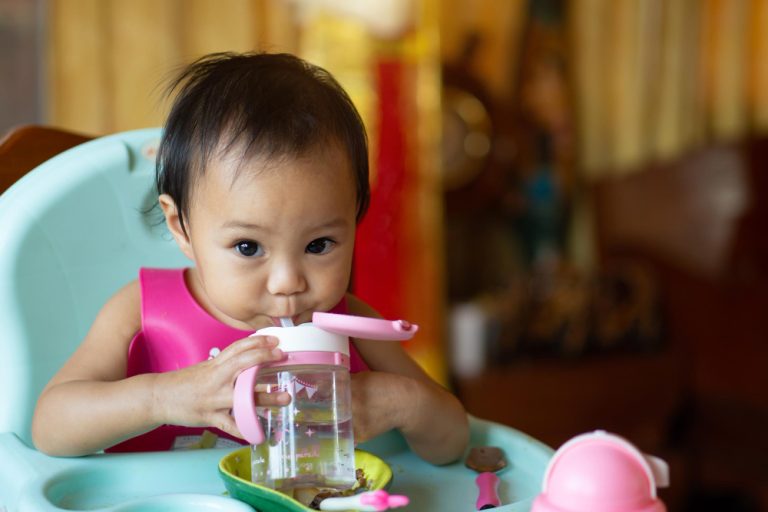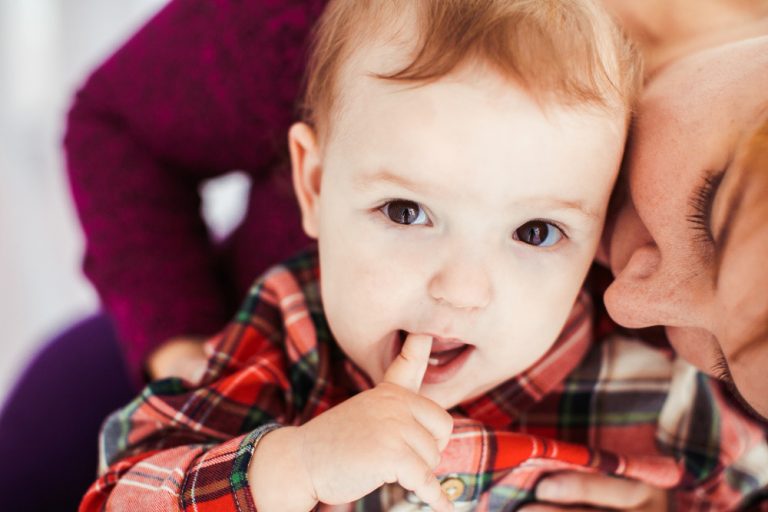When Can Babies Go To The Pool? Swimming with Your Baby
Is your little one ready to make a splash in the pool? Wondering when can babies go to the pool? Imagine the joy on your baby’s face as they experience the wonder of water for the first time. While swimming with your baby can be a delightful bonding activity, but ensuring their safety in the pool is paramount. As a parent, it’s natural to have concerns about how to make this experience both enjoyable and secure.
This blog aims to equip you with the essential tips and guidelines for safe pool visits with your baby so you can both have a fantastic time in the water.
Throughout this guide, we will address common concerns and questions parents have when it comes to swimming with babies, including:
- Age recommendations for introducing babies to the pool
- Key safety measures to implement during baby swim sessions
- Insights on baby swim classes and lessons
- Tips on preparing for your baby’s first pool outing
Let’s dive into the world of baby swimming together: exploring when can babies go to the pool, the joys, challenges, and most importantly, the safety measures to ensure a positive aquatic experience for your little one.
Introduction: When Can Babies Go To The Pool
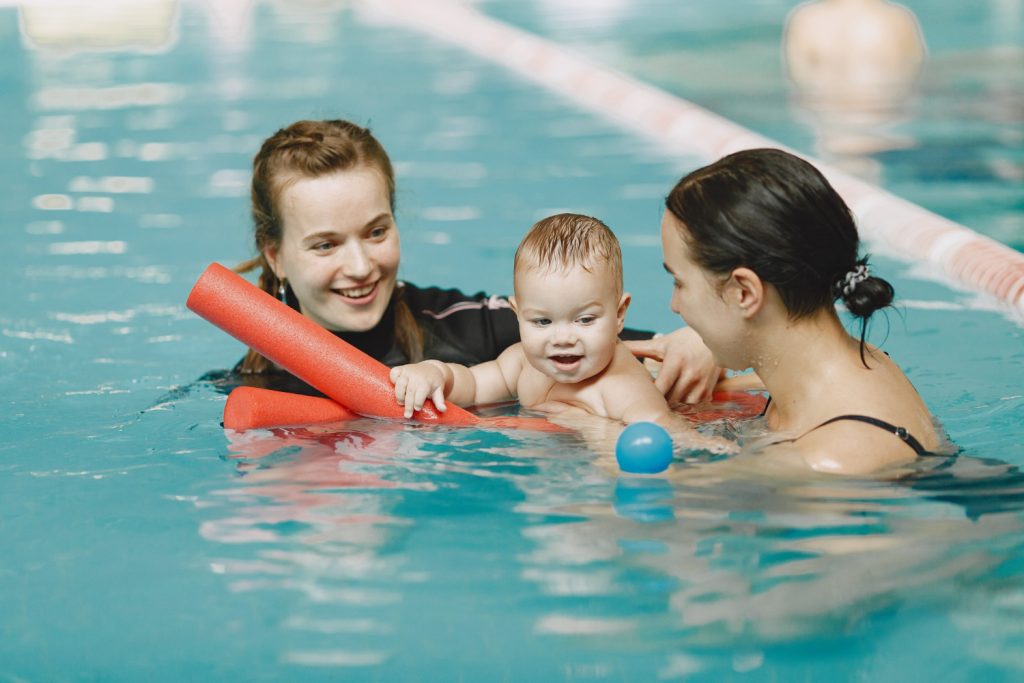
Swimming with babies can be a wonderful bonding experience for both parents and their little ones. Not only does it provide a fun and refreshing way to beat the heat, but it also offers numerous benefits for your baby’s development and overall well-being. However, ensuring their safety in the water should always be a top priority.
Babies as young as a few months old can participate in age-appropriate swimming activities, but it’s essential to consider certain factors before introducing them to the water. Their physical abilities, health condition, and comfort level in the pool should all be taken into account to create a positive and safe experience.
One of the key benefits of swimming for babies is the enhancement of their motor skills and coordination. The water’s buoyancy allows them to explore movement in a weightless environment, promoting muscle strength and flexibility.
Swimming also stimulates their senses and promotes cognitive development as they engage with the watery environment.
Moreover, being in the pool with your baby provides a unique opportunity for bonding and social interaction. It fosters a sense of trust between parent and child as you enjoy the water together. It’s important to remember that these experiences should always be age-appropriate and tailored to your baby’s individual needs and abilities.
In the following sections, we will explore various aspects of swimming with your baby, including age guidelines, safety measures, and tips for a successful swimming experience. Remember, always consult with your child’s healthcare provider before starting any new activities, especially if your baby has any specific health conditions or concerns.
Stay tuned to learn more about what to bring and how to prepare for a swimming session with your little one, as well as important water and sun safety measures to keep in mind.
What to Bring and How to Prepare
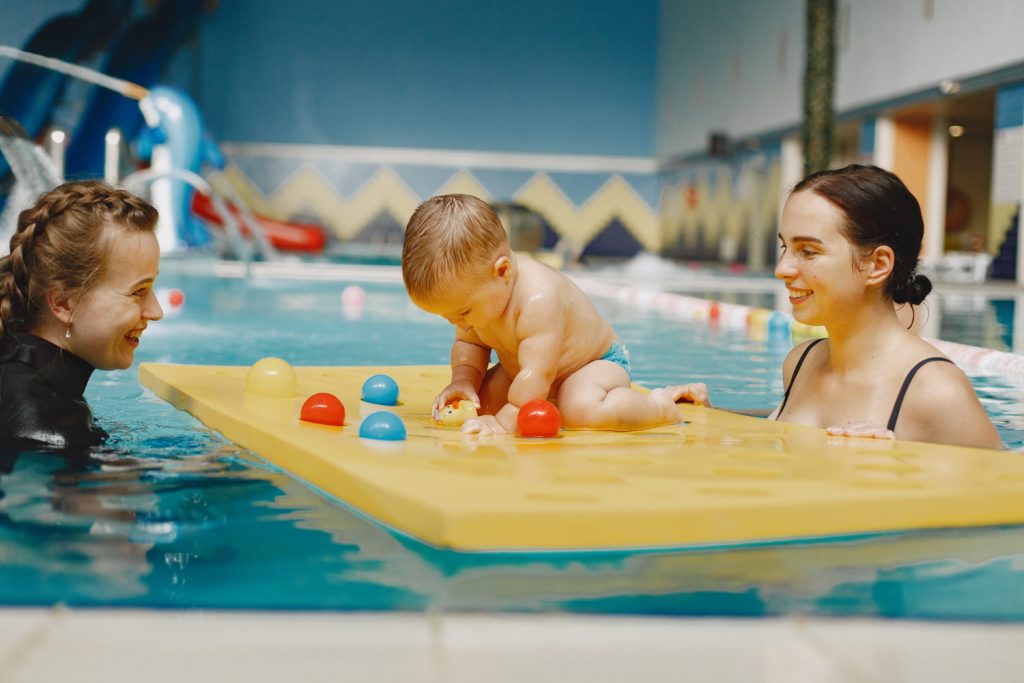
When it comes to taking your baby to the pool, being prepared is key. Here’s a checklist of essential items to bring and tips to ensure a successful swimming session with your little one:
Swim Diapers and Swim Nappies
- Pack an adequate supply of swim diapers or swim nappies for your baby.
- These specially designed diapers are made to be worn in water and help prevent any accidents while swimming.
- Make sure to check the fit and bring extras, just in case.
Sun Protection
- Shield your baby’s sensitive skin from the harsh sun rays by applying a baby-friendly sunscreen with a high SPF.
- Opt for a broad-spectrum sunscreen that provides protection against both UVA and UVB rays.
- Don’t forget to bring a wide-brimmed hat and sunglasses to provide added sun protection.
Towels and Blankets
- Bringing extra towels and blankets is always a good idea.
- You’ll need them to dry off your baby after swimming, as well as to provide a comfortable place for them to sit or lie down.
- Look for towels that are soft and absorbent, and consider bringing a cozy blanket for added comfort.
Extra Clothing
- Pack a change of clothes for both you and your baby.
- Accidents happen, and having spare clothes ensures you’re prepared for any mishaps during or after the swimming session.
- Lightweight and easily removable clothing options, like onesies and rompers, are ideal for babies.
Snacks and Water
- Keep your baby hydrated and nourished by bringing along some snacks and water.
- Opt for healthy and age-appropriate snacks, such as sliced fruits or crackers.
- Pack water in a spill-proof sippy cup or bottle and offer it to your baby throughout the swimming session to help prevent dehydration.
Toys and Floatation Devices
- To make the swimming experience enjoyable for your baby, bring along some age-appropriate water toys.
- Floating toys can help keep them engaged and entertained in the water.
- Additionally, if you plan to use any flotation devices, make sure they are approved for your baby’s age and size, and closely monitor them at all times.
Extra Supplies
- Other items to consider bringing include baby wipes, a changing mat, a waterproof bag for wet clothes.
- Additional items specific to your baby’s needs, such as a pacifier or a favorite toy.
By packing these essential items and following these tips, you’ll be well-prepared for a safe and enjoyable swimming experience with your baby. Remember to check the pool’s rules and any specific requirements beforehand, and most importantly, always prioritize your baby’s safety and well-being in and around the water.
Ensuring Water Safety for Your Baby
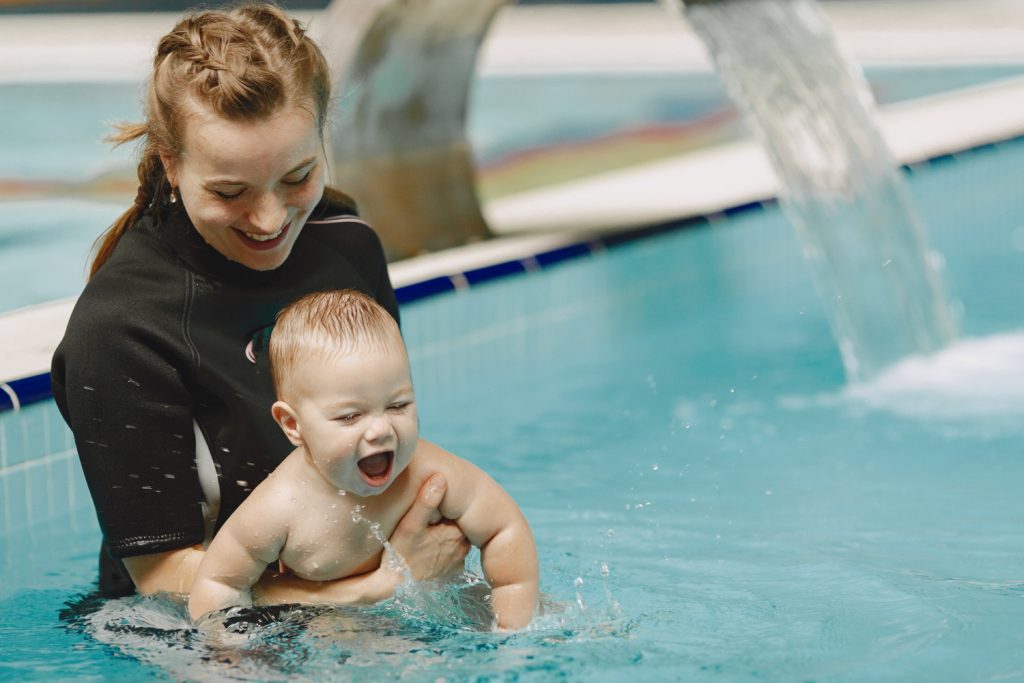
When it comes to swimming with your baby, ensuring their safety should always be a top priority. Here are some essential safety measures and guidelines to follow to make your baby’s swimming experience enjoyable and secure.
Supervision is Key
- Never leave your baby unattended near water, whether it’s a pool, bathtub, or even a small bucket.
- Always keep a close eye on them and stay within arm’s reach.
- Accidents can happen in seconds, and being vigilant is crucial in preventing any mishaps.
Use Flotation Devices Appropriately
- While flotation devices can provide an extra layer of safety, it’s important to use them correctly and as intended.
- Life jackets or approved floatation devices designed specifically for infants can be a good option.
- Ensure the device fits properly and securely without causing discomfort.
Be Aware of Potential Risks
- It’s essential to familiarize yourself with potential risks associated with swimming with your baby.
- These may include accidental submersion, waterborne illnesses, or overheating.
- Being knowledgeable about these risks can help you take appropriate preventive measures and respond promptly if any concerns arise.
Maintain a Comfortable Water Temperature
- Babies are more susceptible to temperature changes, so ensure the water is at a comfortable and safe temperature.
- Aim for a pool temperature around 84-86°F (29-30°C), which is conducive to maintaining a comfortable body temperature for your baby.
Take Breaks and Stay Hydrated
- Just like adults, babies also need breaks from the water.
- Frequent breaks will provide them with an opportunity to rest, hydrate, and prevent overexposure to chlorine or other pool chemicals.
- Offer small sips of water during breaks to keep them hydrated.
Seek Professional Guidance
- Consider enrolling in parent-baby swim classes or seek professional advice from accredited instructors who specialize in teaching infants.
- These classes can provide valuable guidance on water safety, appropriate holding techniques, and valuable swimming skills for both you and your baby.
Remember that every child is unique, and their comfort level in the water may vary. It’s important to respect your baby’s boundaries and never force them into activities they’re not comfortable with. By following these safety measures, you can create a safe and enjoyable swimming experience for both you and your baby.
Age Guidelines for Baby Pool Visits
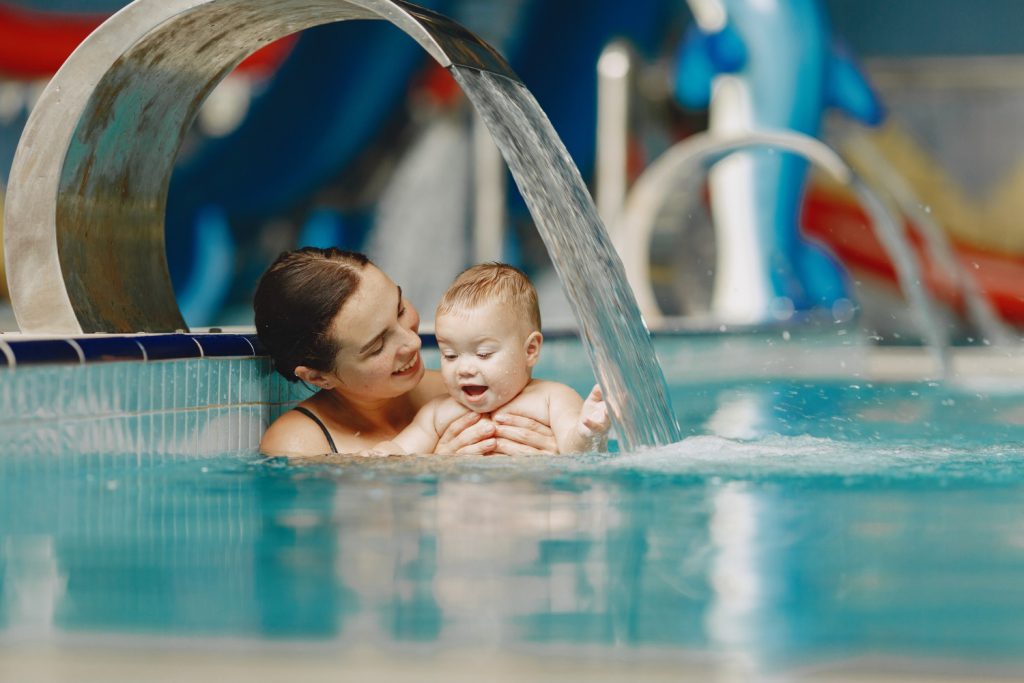
When it comes to taking your baby to the pool, ensuring their safety and well-being is paramount. But at what age can babies start going to the pool? While there isn’t a universally set age, there are some general guidelines to consider.
Developmental Factors
- Babies develop at different rates, so it’s important to assess their individual readiness for the pool.
- Most experts suggest waiting until your baby is at least six months old before introducing them to swimming.
- By this age, they have better head control and coordination, making their pool experiences safer and more enjoyable.
Health Considerations
- Before diving into pool visits, it’s crucial to consult with your pediatrician.
- They can provide personalized advice based on your baby’s health and any specific medical conditions they may have.
- Babies with certain health conditions, such as respiratory problems or infections, may need to wait or take extra precautions when swimming.
Water Temperature
- When taking your baby to the pool, ensure the water is at a comfortable temperature.
- A warm pool (around 84-88 degrees Fahrenheit) is ideal for babies, as it minimizes the risk of them getting too cold or experiencing discomfort.
- It’s essential to look for pools with regulated temperatures, especially for infants who are more sensitive to temperature changes.
Parental Supervision
- Regardless of your baby’s age, constant parental supervision is vital during pool visits.
- Always stay within arm’s reach of your baby and never leave them unattended in the water.
- Remember that accidents can happen quickly, and being attentive is crucial for your baby’s safety.
Swim Diapers and Hygiene
- Before heading to the pool, make sure your baby is wearing a proper swim diaper to prevent any accidents.
- Remember to change the diaper regularly to maintain good hygiene for both your baby and others in the pool.
- Additionally, follow any specific rules or guidelines set by the pool facility regarding diaper usage.
By considering these age guidelines and developmental factors, you can make informed decisions about when to start taking your baby to the pool. Prioritizing your baby’s safety, health, and well-being will ensure a positive and enjoyable swimming experience for both of you.
Swimming Classes for Babies
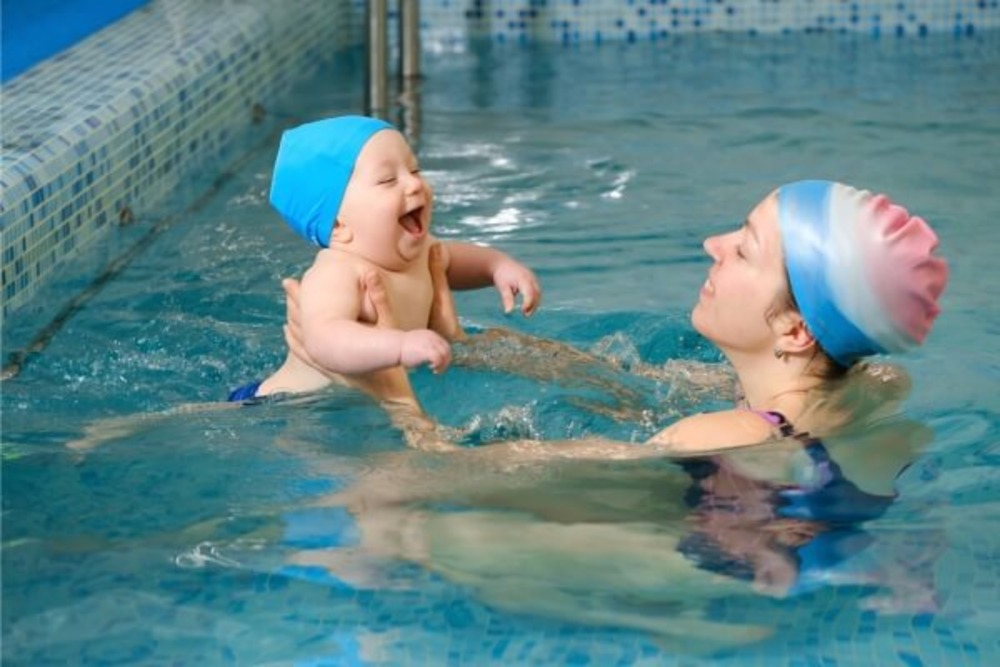
Swimming classes for babies offer a wonderful opportunity for both you and your little one to enjoy the water together. These specialized classes are designed to introduce babies to the joy of swimming in a safe and structured environment.
Here’s what you need to know about baby swimming classes:
Benefits of Baby Swimming Classes
1. Water Familiarity
Baby swimming classes help infants become familiar with being in the water from an early age, promoting water confidence and reducing the chances of developing water anxiety later in life.
2. Physical Development
The gentle movements and exercises in baby swimming classes can contribute to the development of essential motor skills, muscle strength, and coordination.
3. Bonding Experience
Attending swimming classes with your baby allows for quality bonding time, as you engage in activities together and create lasting memories in the water.
4. Water Safety Skills
Baby swimming classes often incorporate basic water safety techniques, teaching babies how to respond in the water, grasp the side of the pool, and float on their backs.
Finding Baby Swimming Classes
1. Local Swimming Schools
Check your local community centers, swim schools, or sports facilities for baby swimming classes. They often offer age-appropriate classes for infants, typically starting around 6 months old.
2. Parent-Baby Swim Programs
Look for parent-baby swim programs that provide a supportive environment for both you and your baby to learn and enjoy swimming together. These programs are often led by certified instructors who specialize in teaching infants.
3. Recommendations
Seek recommendations from other parents who have already enrolled their babies in swimming classes. They can provide valuable insights into the quality and suitability of different programs.
What to Expect in a Baby Swimming Class
1. Qualified Instructors
Baby swimming classes are usually led by experienced instructors who are trained in working with infants and ensuring their safety in the water.
2. Structured Activities
Classes typically include structured activities such as floating, kicking, and gentle water play to engage babies and promote their comfort in the water.
3. Parent Involvement
Parents are actively involved in baby swimming classes, providing hands-on support and guidance to their little ones as they explore and learn new skills.
4. Safety Measures
Instructors prioritize safety by maintaining a low teacher-to-student ratio, monitoring water conditions, and enforcing hygiene protocols such as swim diaper usage.
Remember, each baby is unique, so it’s important to choose a swimming class that aligns with your baby’s developmental stage and your comfort level. Always consult with your pediatrician before starting any swimming program for your baby.
Water and Sun Safety for Babies
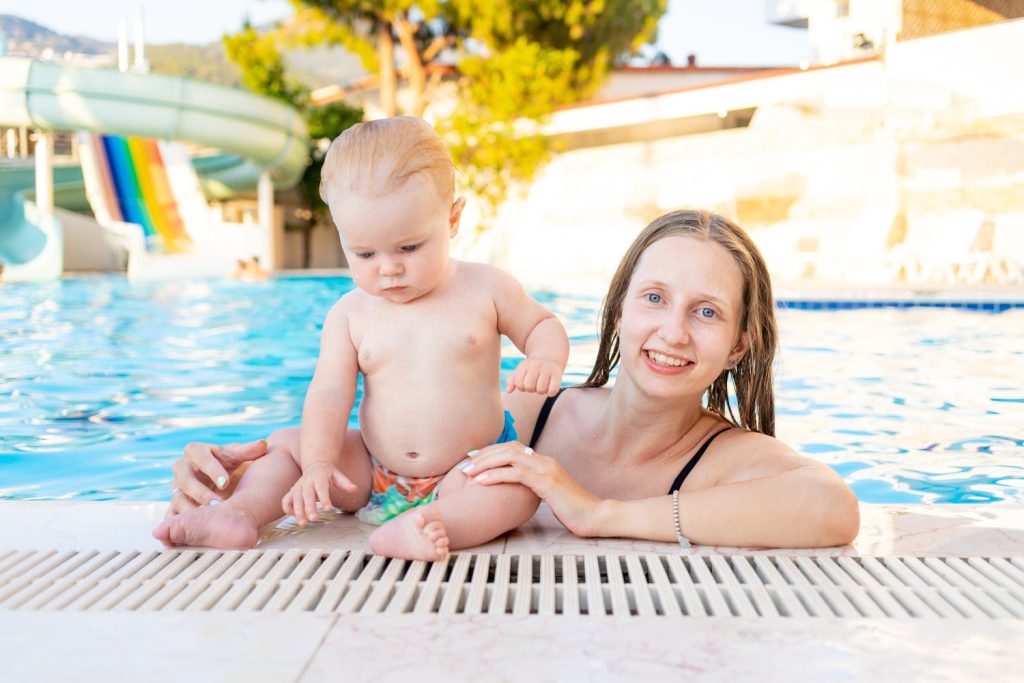
Ensuring water and sun safety for babies is crucial to protect their delicate skin and overall well-being. Here are some essential tips to keep in mind when taking your baby to the pool or any outdoor water activities:
Proper Hydration
- Babies are more susceptible to dehydration, so it’s important to ensure they stay hydrated.
- Offer them frequent, small sips of water or breast milk.
- Avoid sugary or caffeinated drinks, as they can dehydrate your baby further.
Sun Protection
- Always shield your baby from direct sunlight, especially during peak hours (10 am to 4 pm).
- Use a wide-brimmed hat, protective clothing, and sunglasses to minimize sun exposure.
- Apply a broad-spectrum sunscreen with a minimum SPF of 30 to your baby’s exposed skin.
- Choose a sunscreen designed specifically for infants, and reapply regularly as directed.
Recognizing Signs of Overheating
- Watch for signs of overheating, such as excessive sweating, flushed skin, rapid breathing, or fussiness.
- Take your baby to a shaded area or indoors if they show any of these signs.
- Dress your baby in lightweight, breathable clothing to prevent overheating.
Pool Safety
- Ensure the pool water is at a comfortable temperature for your baby.
- The ideal range is between 86°F and 92°F (30°C and 33°C).
- Use proper flotation devices designed for infants and always keep your baby within arm’s reach in the water.
- Never leave them unattended, even for a moment.
Avoiding Chemical Exposure
- Rinse your baby with clean water after swimming to remove any chlorine or other chemicals from their skin.
- Pat them dry gently with a soft towel.
- Be cautious if your baby has sensitive skin or any skin conditions.
- Consult with your pediatrician before swimming in chlorinated pools or using certain water treatments.
Remember, water and sun safety should be a priority when swimming with your baby. These measures will help protect their skin, prevent overheating, and ensure a pleasant and enjoyable experience for both of you.
The Final Note: When Can Babies Go To The Pool
When can babies go to the pool? Swimming with your baby can be a joyful and bonding experience, but it’s crucial to prioritize their safety and ensure age-appropriate activities. By following the guidelines and tips provided in this article, you can create a positive and safe water experience for your little one.
Throughout this guide, we have emphasized the importance of water and sun safety, the necessary preparations for a successful swimming session, and the recommended age range for introducing babies to the pool. By adhering to these practices, you can ensure that your baby stays protected and enjoys their time in the water.
Remember to always supervise your baby when they are near or in the pool, utilize appropriate flotation devices if necessary, and be aware of any potential risks. Taking part in baby swimming classes can also be a great opportunity for both parent and child to learn valuable water safety skills.
In conclusion, make sure you establish good water safety habits, stay hydrated, protect your baby from the sun, and be mindful of their comfort and well-being. Happy swimming!

